FRAMES Artist-in-Residence December 2022: Justyna Neryng
PART 1 – PART 2 – PART 3 – PART 4 – PART 5
PART 1 – DECEMBER 4, 2022
W. Scott Olsen in conversation with Justyna Neryng, introducing our next Artist-in-Residence, talking about her work and her plans for this particular FRAMES Artist-in-Residence series.
Justyna Neryng is a Polish born, self-taught photographic artist, with a background in fashion and painting. She works with analog and digital cameras with a particular interest in portraiture and the human body. She has won several awards and had her work exhibited and recognised by the Royal Photographic Society. She lives and works in the United Kingdom.
Leave your questions to Justyna in the comment section below and he will do his best to answer them all.
PART 2 – DECEMBER 11, 2022
THE ONGOING MOMENT
Making big art in a small room
For the last ten years or so I have been using my living space as a studio. It comes with its own creative limitations of space, I always feel I need more. But it is a safe womb-like space I have created to explore ideas and generate my work. I started to use the space when I photographed my then young daughter for my “Childhood lost” project which I have been honoured to have published in FRAMES.
Since then the space has developed, with the addition of colour rolls, lights and flags. Still learning my way with lighting, but it is all part of the creative journey. The space is a place I can truly call mine and it is perhaps a sacred space for my collaborators and models to feel safe in. The creative energy of my practise steeped in its walls and furnishings. Something that would not be available to me in a hired studio. The space changes a little with each project I undertake, constantly shifting in its layout and purpose.
ARTIST’S HOME
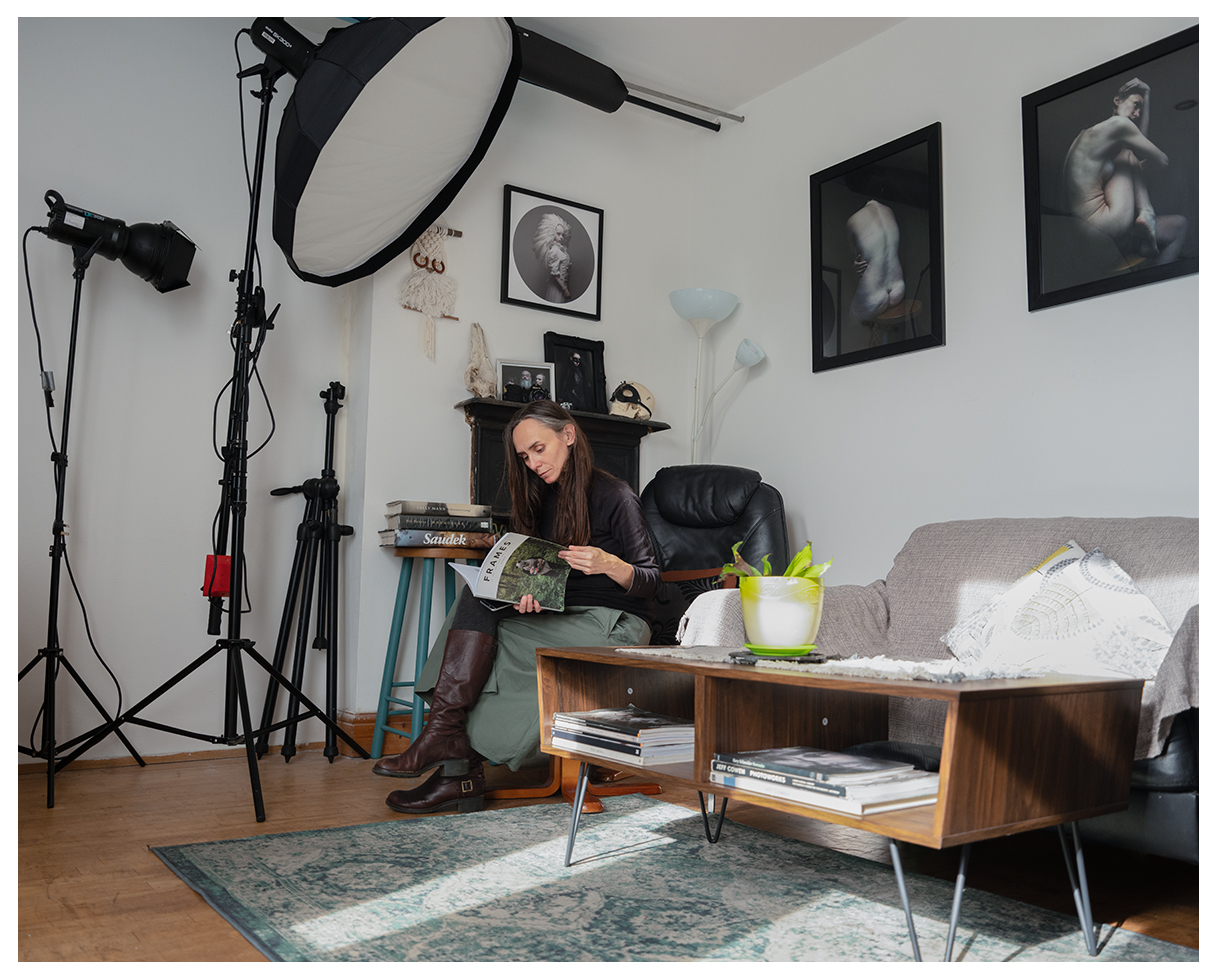
ARTIST’S STUDIO
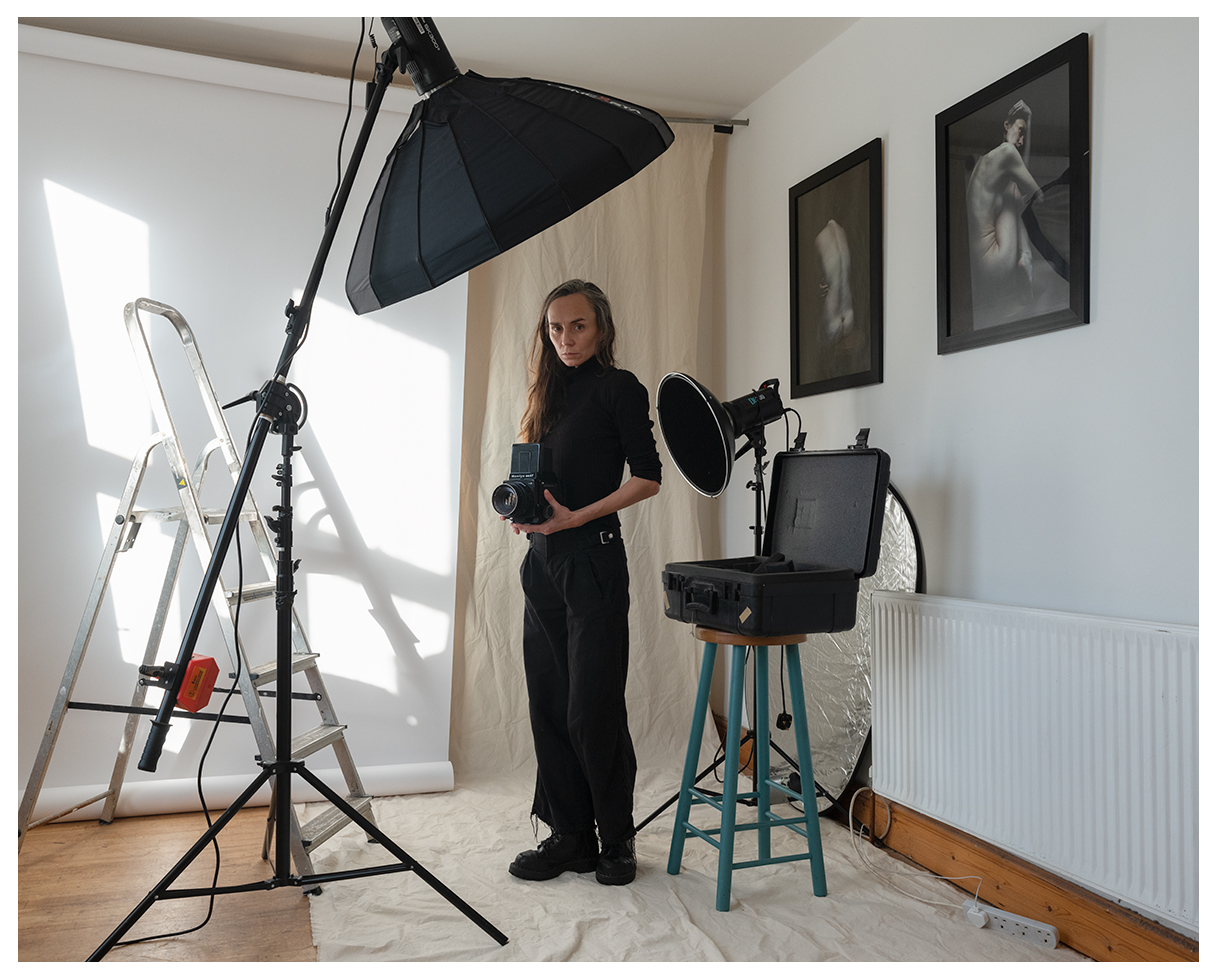
PREPARATION BEFORE THE SHOOT
PHOTO SESSION NUMBER 1
For this shoot I have asked Frankie to work with me. She is one of my favorite models/collaborators. I have photographed her many times over the past 10 years in which time we have got to know each other very well and became good friends.
Frankie is a life model and creative in her own right, so our working relationship is often an exchange of ideas.
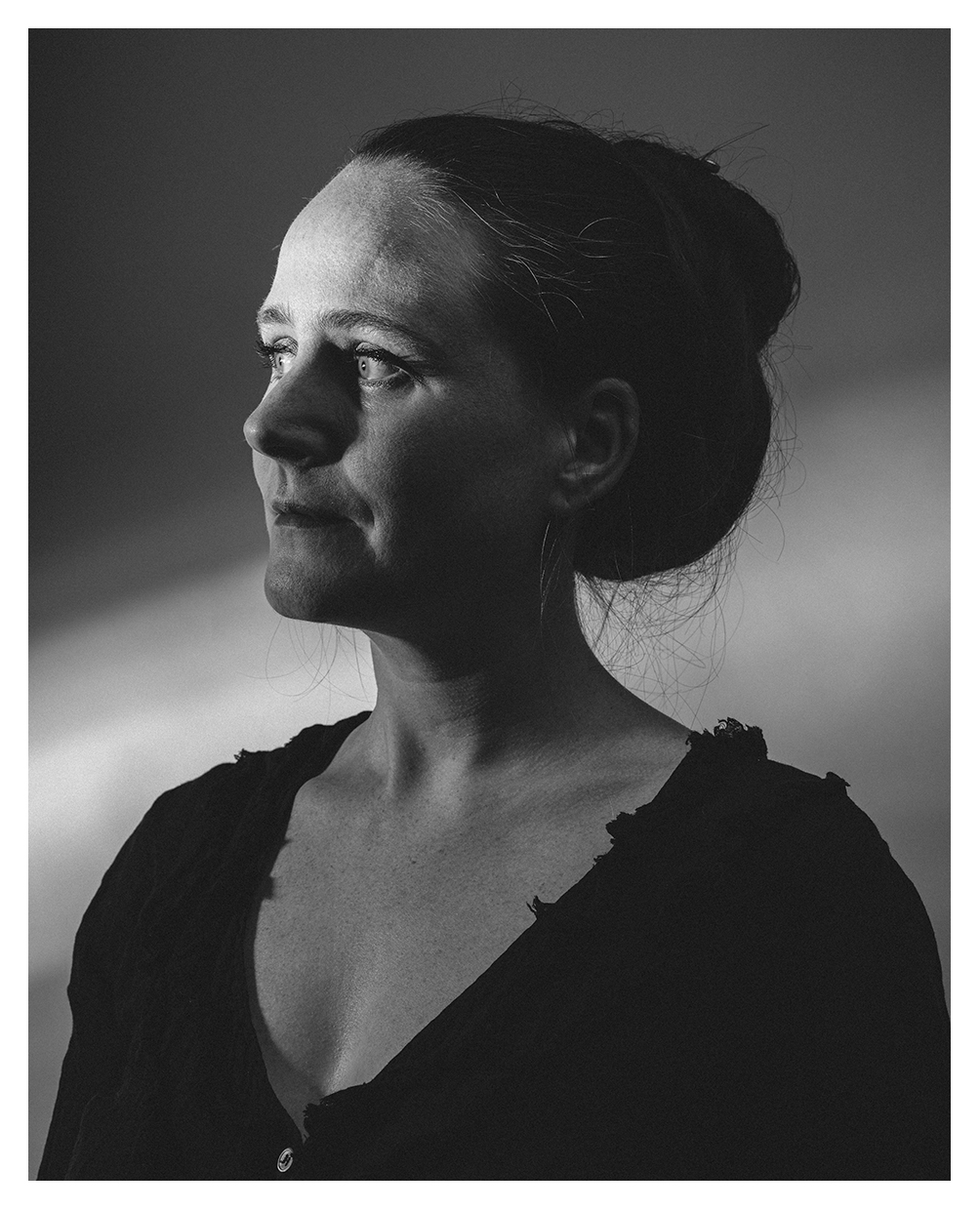
FRANKIE’S PORTRAIT

NOTES ON BLACK & WHITE PHOTOGRAPHY
Colour is often my first choice of shooting. But b&w photography unlike colour has the power to transcend the reality. As soon as something is in b&w it sends a signal that we are already one step out of it. It is not how we see the world, but how the camera sees the world. The lack of colour gives a space in the image for interpretation, for the mindeye to fill in the gaps. A potential for ambiguity, for some poetry to enter the frame.
I have tried to do this with my colour photography, the colour in my images is not always really what was there, but it still anchors the viewer closer to our reality than the photographic reality in a way that black and white does not. It’s a new journey for me. Trying to see in terms of tone and spills of light. As part of this journey I have decided to undertake both analogue and digital processes to see how this might help me re-discover the photograph.
CONCEPT OF THE SHOOT
The aim is to produce a couple of images, as a diptych , shooting both medium format Fujifilm GFX 50S II and Mamiya RB 67 in black and white. My intent is to use the digital camera as a way of finding the image. To test experiment with light and form and see where the shoot is going and then use the analogue camera when I feel I am on firmer ground to capture the images.
Going back to analogue and especially into a wet darkroom is something I have not done for years. A photographic journey all the way back to my childhood and memories of the darkroom and my father. I am both excited and terrified by the idea, but this is a good place for an artist to be. If you know the outcome is, it is probably not worth doing.
So I am using this as an opportunity to do some exploring of both my memories and my process and to see what happens.
Diptych…
Why Diptych?
I have worked with these in the past and am fascinated by the way they infer a passage of time between one shot and another. They expose a process of how the images were made, getting back to that idea of dialogue. The images converse with each other and invite the viewer to join the conversation.
Working with diptych is also, perhaps, away of making the images stand out from the ocean of photographs we find ourselves in. It is a open ended process. This is why I enjoy making images for myself, rather than a client, so much. It becomes a journey, with an unclear destination.
At this stage I have no idea how the images will come together but am trusting that black and white, working with my trusted collaborators and trusting in my own story will be enough to reveal… something!
DIGITAL LIGHT TEST
DIGITAL SKETCHES
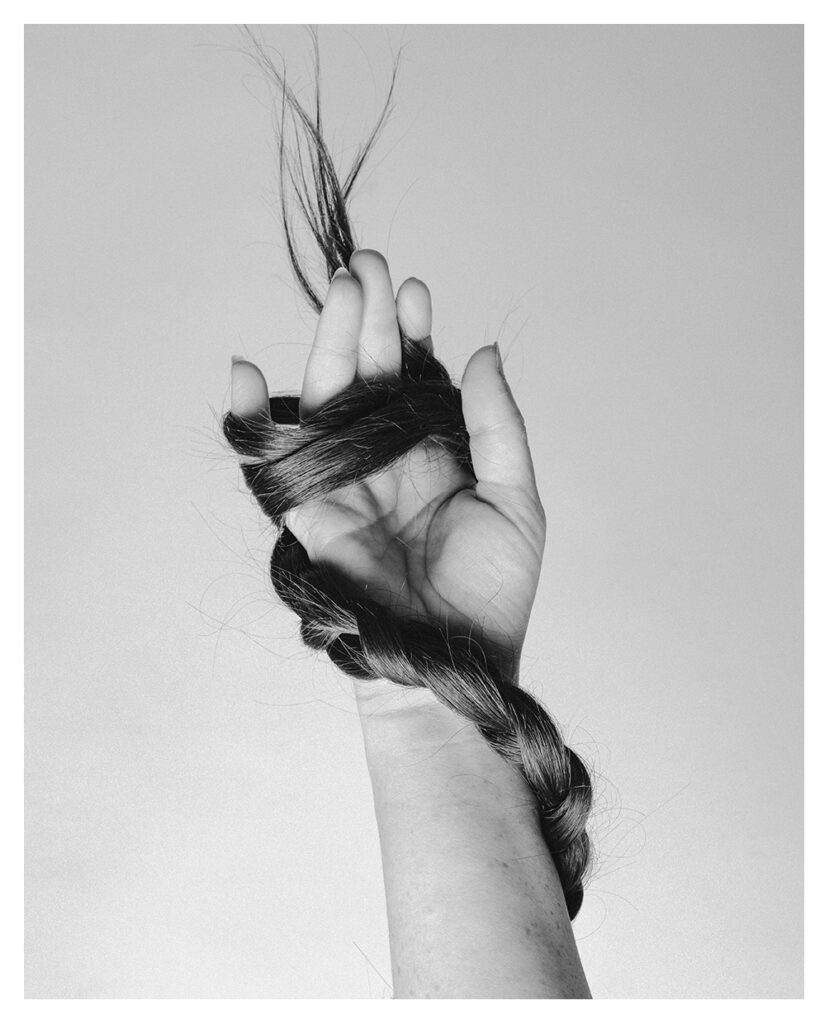

ANALOGUE
1 POLAROID TEST & 10 SHOTS
Next week I will be printing my photos of Frankie in the darkroom.
Leave your questions to Justyna in the comment section below and he will do his best to answer them all.
PART 3 – DECEMBER 18, 2022
THE DARKROOM
This is very exciting for me, my first visit to an analogue darkroom since childhood!
Until now I have always scanned my negatives which still leads me to edit in Photoshop and I have so missed the alchemical magic that happens in the darkroom. This is by no means a “how to” tutorial but rather a document of my journey on the darkroom. I wasn’t trying to make the perfect print. That I can do with much more control with digital editing. I wanted to rediscover what a photograph could look like. I wanted to embrace the messy outcomes, the mistakes, the process, all those marks left by the process that have been “ironed out” of digital photography.
Perhaps, just as importantly, I wanted to revisit the memories of my father in the darkroom during my childhood.
There seems to be an increase of interest in analogue photography. Many of my collaborators in the studio are young people raised on only digital photography that have a deep fascination with the “old” processes. It perhaps my many conversations with these sitters that put the idea in my head of a return to the darkroom. These images are made in a beautiful community darkroom near where I live. The very physical nature of the darkroom makes it feel like a creative womb to create work in. As soon as I entered I could feel a rush of excitement that no editing computer has ever given me. I felt like I was home.


I might be home but I have no idea where the kitchen is! This is me confronted by a 35mm contact sheet press. The half smile as I realise I am printing from 120 roll film and trying to remember how on earth I make a contact sheet with that.
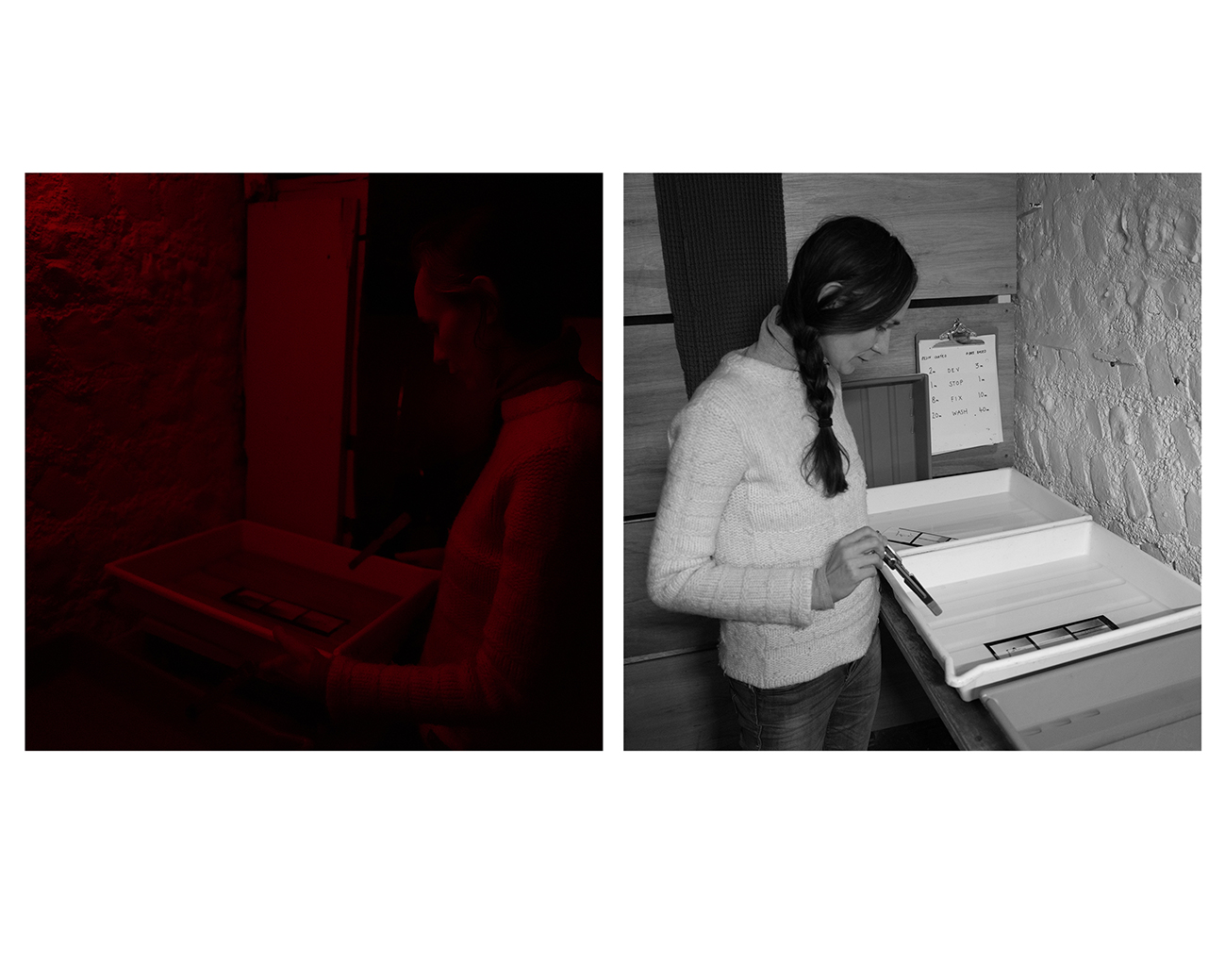
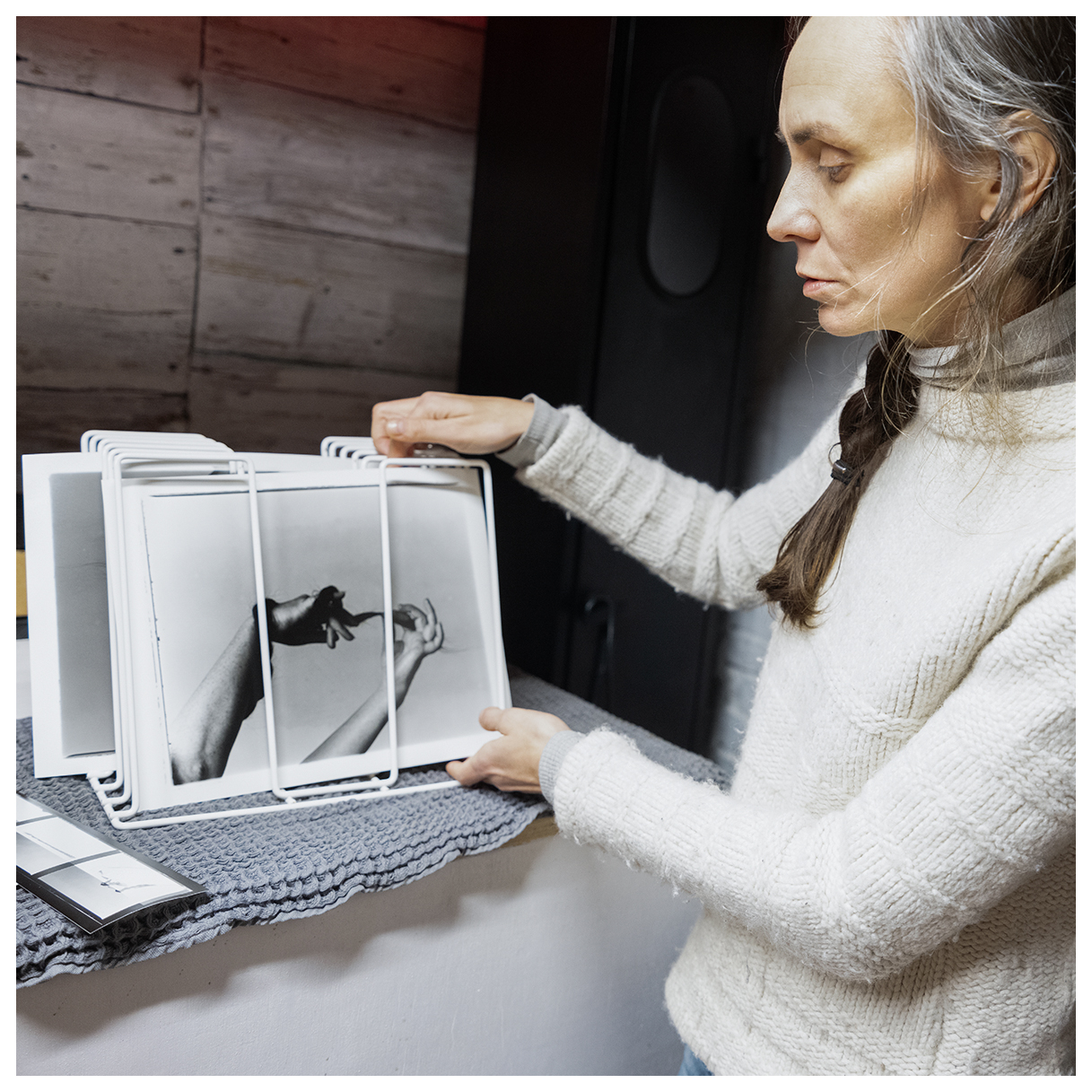
Prints in the drying rack after a very creative if not frustrating day in the darkroom. It now is up to me to find a way of combining the ways I work digitally with analogue.
I have fallen in love the darkroom again and if a can workout how to fit it into my practise, I will be returning here time and time again. Perhaps making digital negatives to print from.
Next week I will be back in the studio , behind and in front of the camera.
Leave your questions to Justyna in the comment section below and he will do his best to answer them all.
PART 4 – DECEMBER 27, 2022

“I give my soul now one face, now another, according to which direction I turn it. If I speak of myself in different ways, that is because I look at myself in different ways. All contradictions may be found in me.”
Michel de Montaigne
QUICK ARTIST PORTRAIT
About self portraiture
as a process
As an artist, I often use myself ,mainly to experiment, occasionally creating art in my own image, immortalising myself in the process.
I don’t make a lot of projects but the ones I have done are very much an outcome of a self portrait. And it’s always handy to have a model on hand when you have a good idea too.
Self portraiture is something I find increasingly fascinating. Obviously we are not talking about the ubiquitous selfie, but rather a dialogue with myself via the medium of photography. As I have grown older the way I look at myself has changed. I feel braver, becoming increasingly more honest with the images I make.
This “brave honesty” is something I have come to, through my self portraits, but now apply when making images of others. So many people come to me wanting to be part of my work, and I think it is because they are drawn to this honesty.
I have also become quite fascinated by artists working with found images and collage. Especially the work of John Stezaker. I am trying to adopt a similar process but by looking at my own images as “found” rather than hard fought for. They are hard fought for, while I am in the studio, but I try to come to them “fresh” when I select or edit.
I love the way Dirk Braeckman works to. Leaving his negatives to “mature” for years before taking them into the darkroom having completely forgotten the reasons for making the image in the first place. It’s a bold process and in terms of time not one I feel I can afford to do just yet.
So my self portraits are not only a dialogue between me and the camera, but also with other photographers I admire. It is a way for me to find a way of doing things, and to introduce an element of play into my process. I can endlessly experiment without feeling the pressure of keeping sitters happy, or any time constraints.
Session 1 – Studio Setup
First Attempt
Background Change
Second Attempt
Contact Sheet
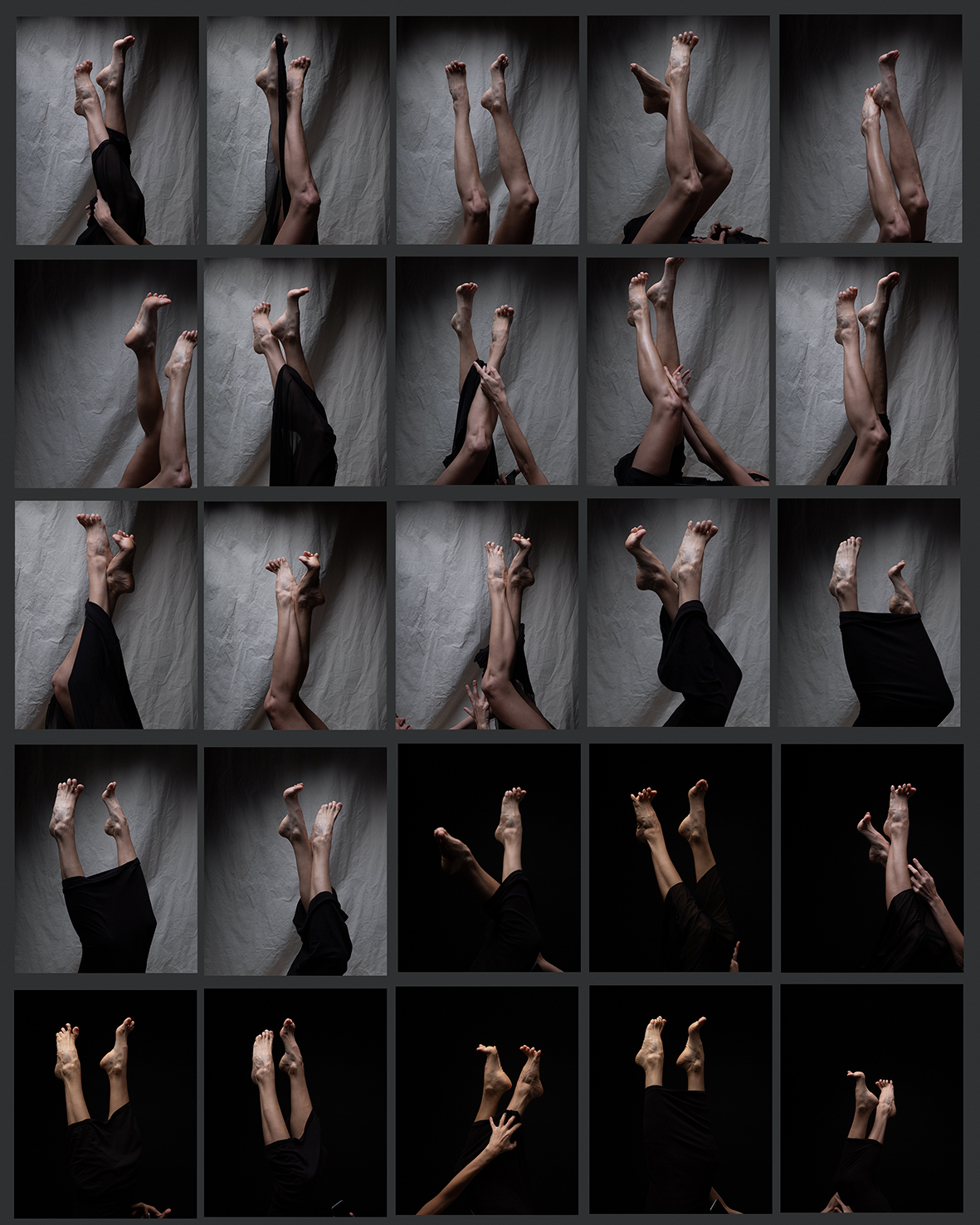
Quick Edit
Final Images
SPECIAL GUEST
My special guest today is Nell , my daughter (the girl from Childhood Lost series) . In fact it was her idea!
I described the Childhood Lost project as a “series of self portraits in a different body” at the time. I still look back at it with much pride and emotion. Nell has since grown into woman and represents a completely different generation to me. So I can no longer really use her as a stand in for me, she is so much her own person now. We decided to focus more on our relationship both as mother and daughter and as friends.
I have been inspired for many years by the work of Pina Bausch, first seeing her work in the film “Pina” by Wim Wenders. The way she finds a new language of the body, the unusual and awkward forms often find their way into my own work. I wanted to explore this with Nell, to perhaps find a way to “perform” our relationship to the camera. These may be the stepping stones to something more with Nell, or perhaps with other models.
First Attempt
Final Shot
These photographs of Nell and I are works in progress really and hopefully a beginning of a new series we will collaborate on for the next few years . I never know how long I will have Nell as a part of a project. She has her own life now, and although we have found a common interest with the idea of dance, performance and photography, she will always have the last say in these projects, which only makes these times and shoots together all the more precious.
A lot has changed with my approach to photography since I shot Childhood Lost, and working with Nell again has really highlighted this. Gone are the elaborate costumes and painterly compositions of Childhood Lost, my practise has become so much more pared back. Focusing more on the relationship between my sitters and me, and this is never more the case that when I work with Nell.
I hope this is a project that I can revisit over the coming years to document the relationship’s development and our inevitable aging and changing roles in life.
Next week I will be printing small test prints.
Leave your questions to Justyna in the comment section below and he will do his best to answer them all.
PART 5 – JANUARY 5, 2023
I make the majority of my prints digitally, using giclee processes. Although I have a love of the analogue darkroom and was so privileged to make some prints for the project as I would have done in my childhood, my photography has had to change with the times. So many analogue papers have disappeared and the variety of papers offered by giclee printing is hard to match. Digital printing also gives me a lot more choice when considering the size of the final images. I have made prints in the past on a really large scale, over 2 meters on the longest side. Quite a straightforward process using giclee but a very expensive and time consuming achievement in an analogue darkroom.
Digital printing also offers so much more control than analogue. Of course you lose all those serendipitous moments, the happy accidents of the darkroom, but nothing beats digital when it comes to control and consistency.
I use a local photographer to do my printing that makes prints for a select group of artists for exhibition as well as for museums.
The prints are made with an EPSON P9500, one of the actual machines Hahnemuhle use to calibrate their papers on. Perhaps unsurprisingly then I tend to use Hahnemühle papers when making my prints with a preference for fine art pearl, which has a lovely finish and great tonal range, especially for black and white.

I start by running a test strip to make sure the head alignment is correct, and then a test strip of the actual image. Usually they have to be brightened a touch in the mid tones as we are so used to looking at images that are backlit rather than on paper. Once adjustments have been made we roll out the final print.


The prints are checked using a loupe to ensure there are no imperfections. And then trimmed ready to be hand signed and numbered. As these are artists proofs they just tend to get dated, so I can keep track.
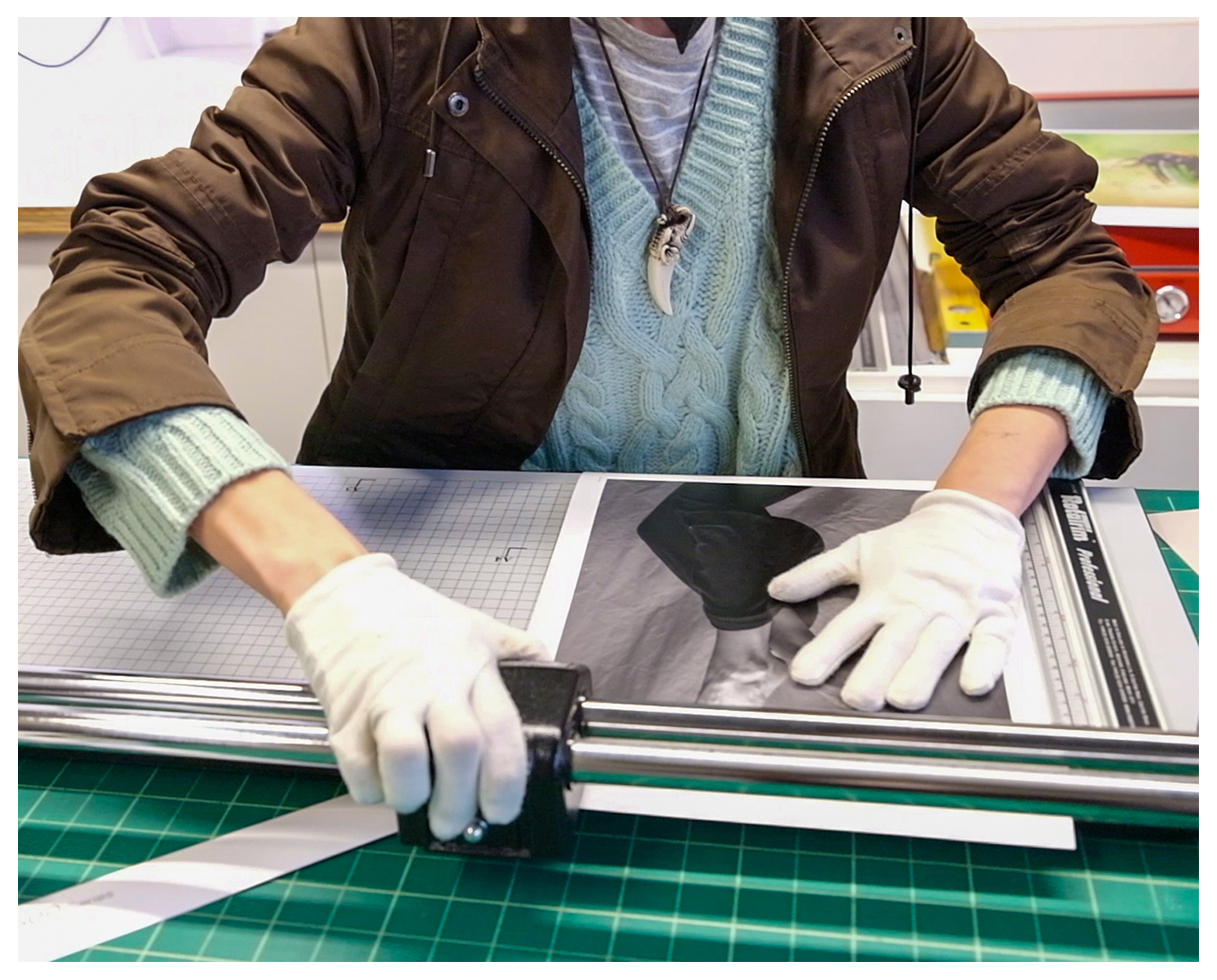
I tend to try and live the prints for a while so they help to inform me of what to do moving
forward. There is certainly quite a difference between the hands on punk attitude of the wet dark room verses the clinical process of making inkjet prints.
Prints Presentation
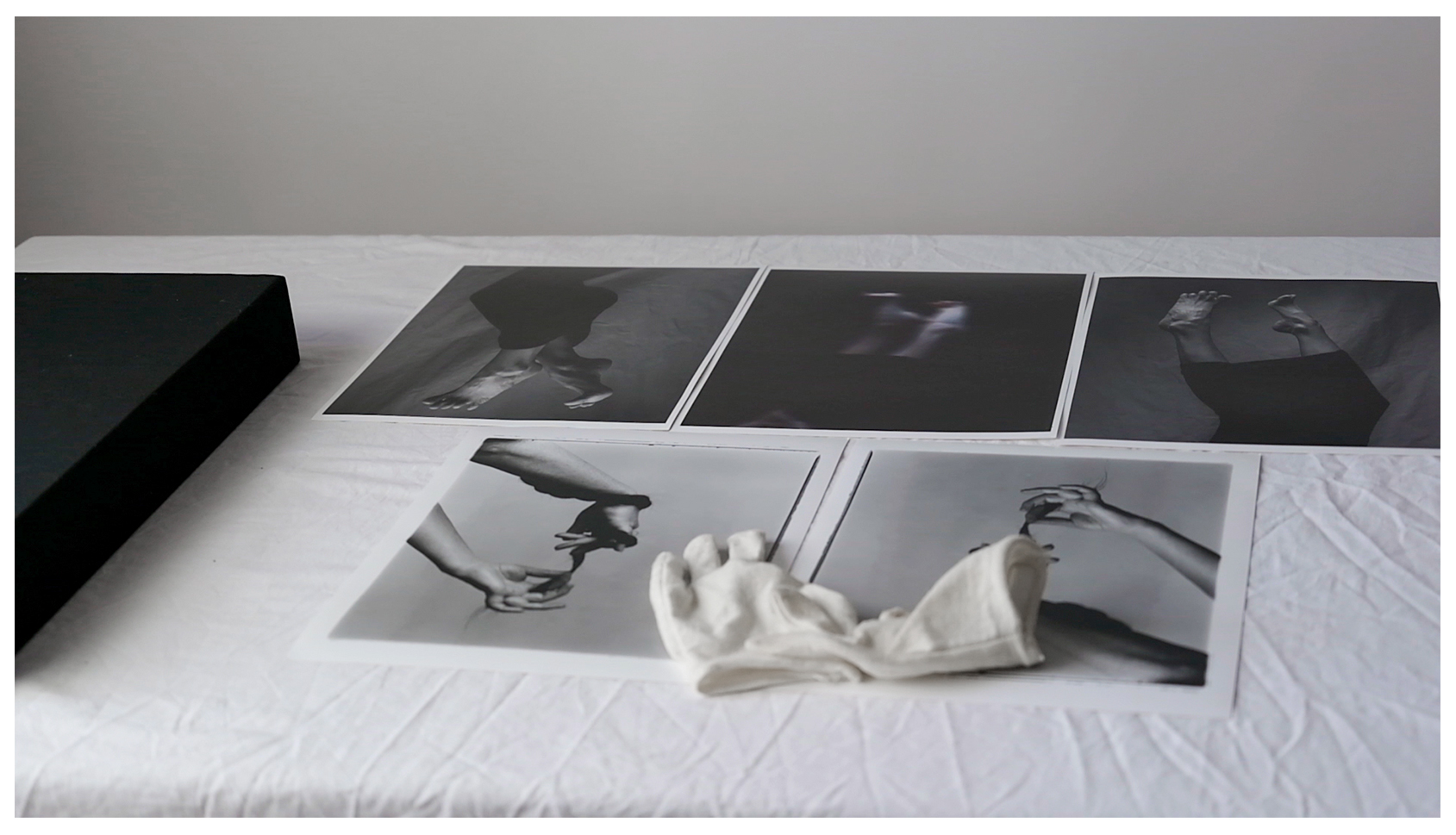
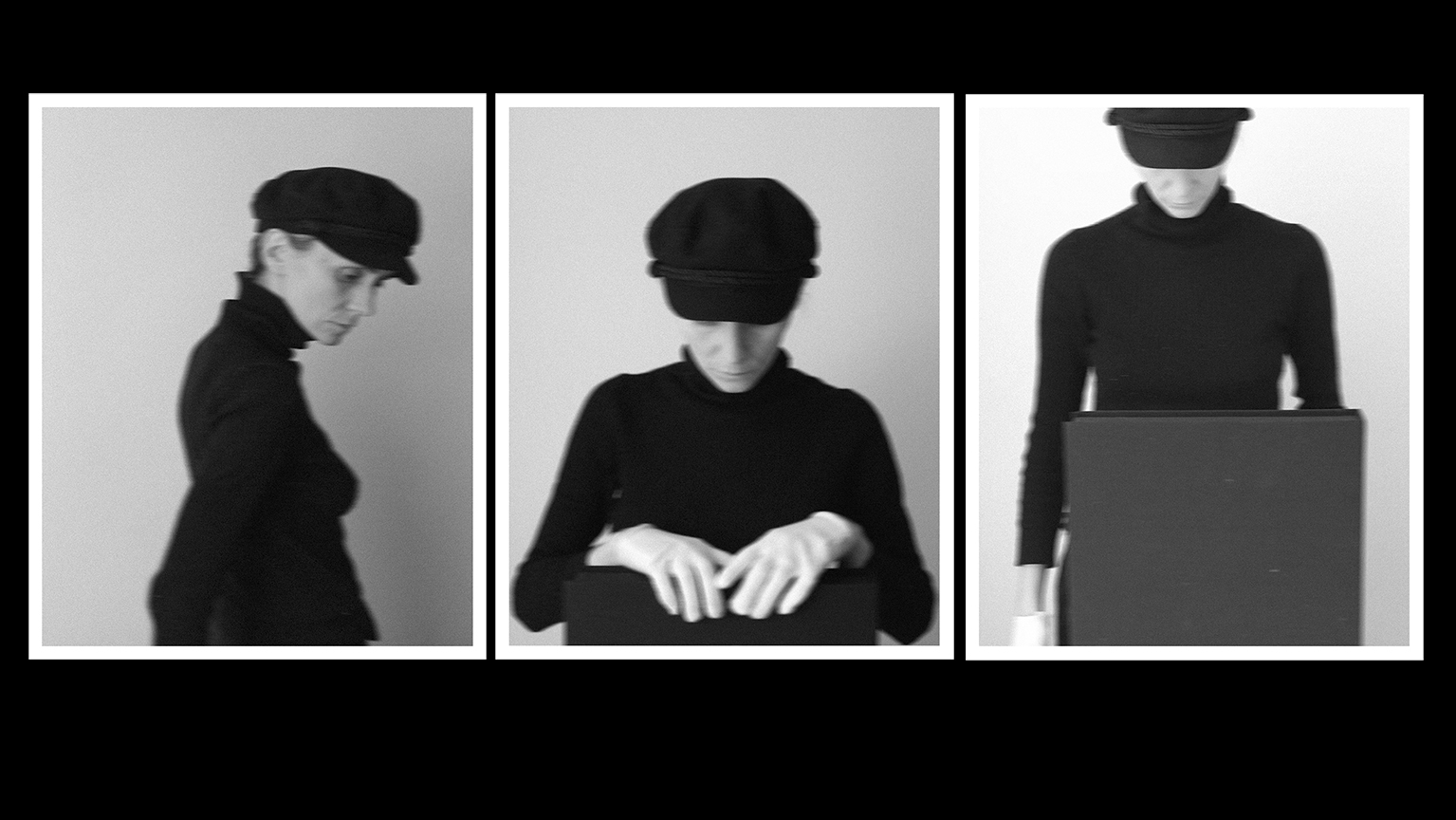
Final Choice
I have been toying with the idea of getting more hands on with the inkjet process, to add hand painted elements, perhaps even hand tinting images printed on a suitable fine art paper. I am very mindful of the medium in which I am working. The light and chemistry of the wet darkroom has its own dialogue, and I would like to develop something like this with the ink used in the giclee process. I am very inspired by the work of Jan Sudeck which could be a start point for me and a development of this project.
I hope I have given some insight into my process and certainly that it is a continuous process, always being revised and explored.
Thank you FRAMES for this opportunity and I am grateful for the support of this
community.
Justyna Neryng
Leave your questions to Justyna in the comment section below and he will do his best to answer them all.


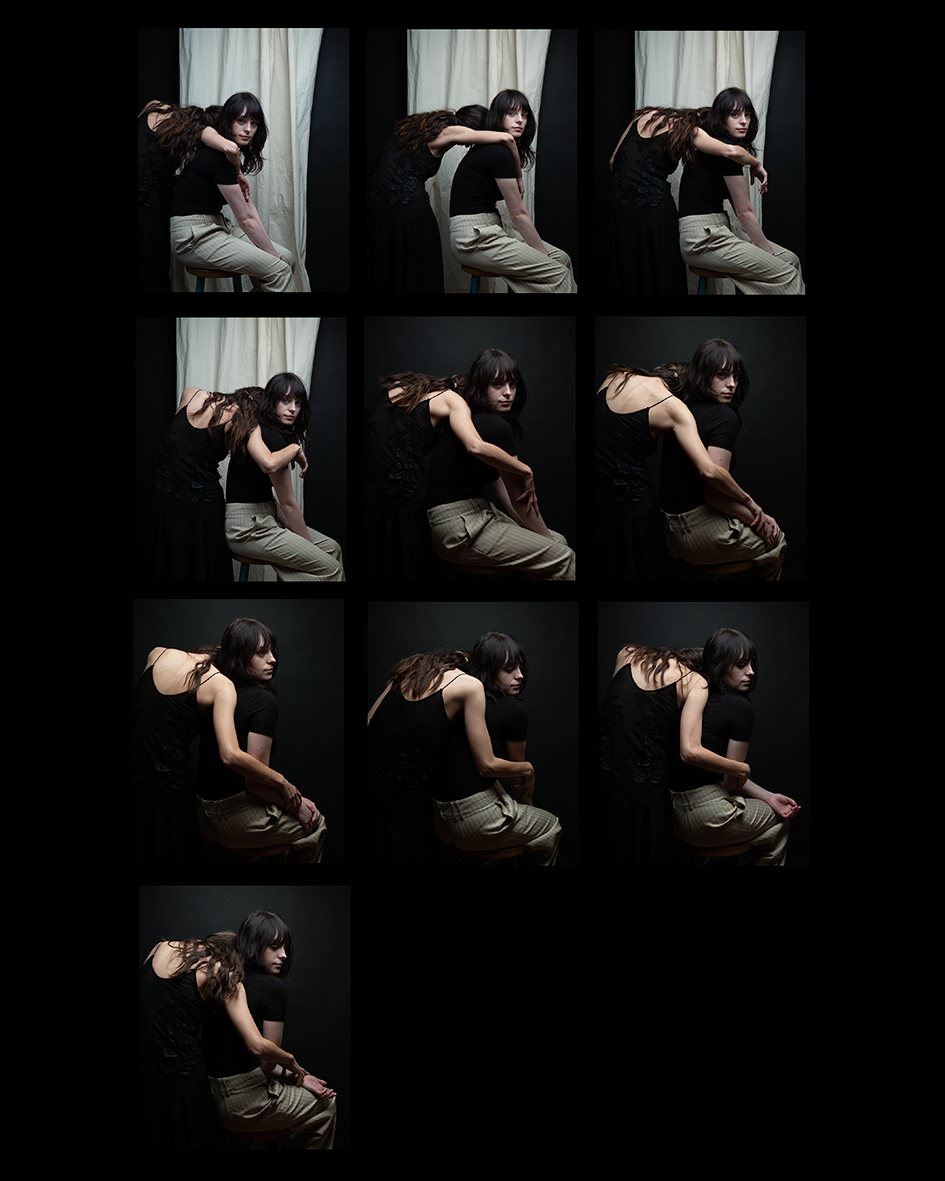

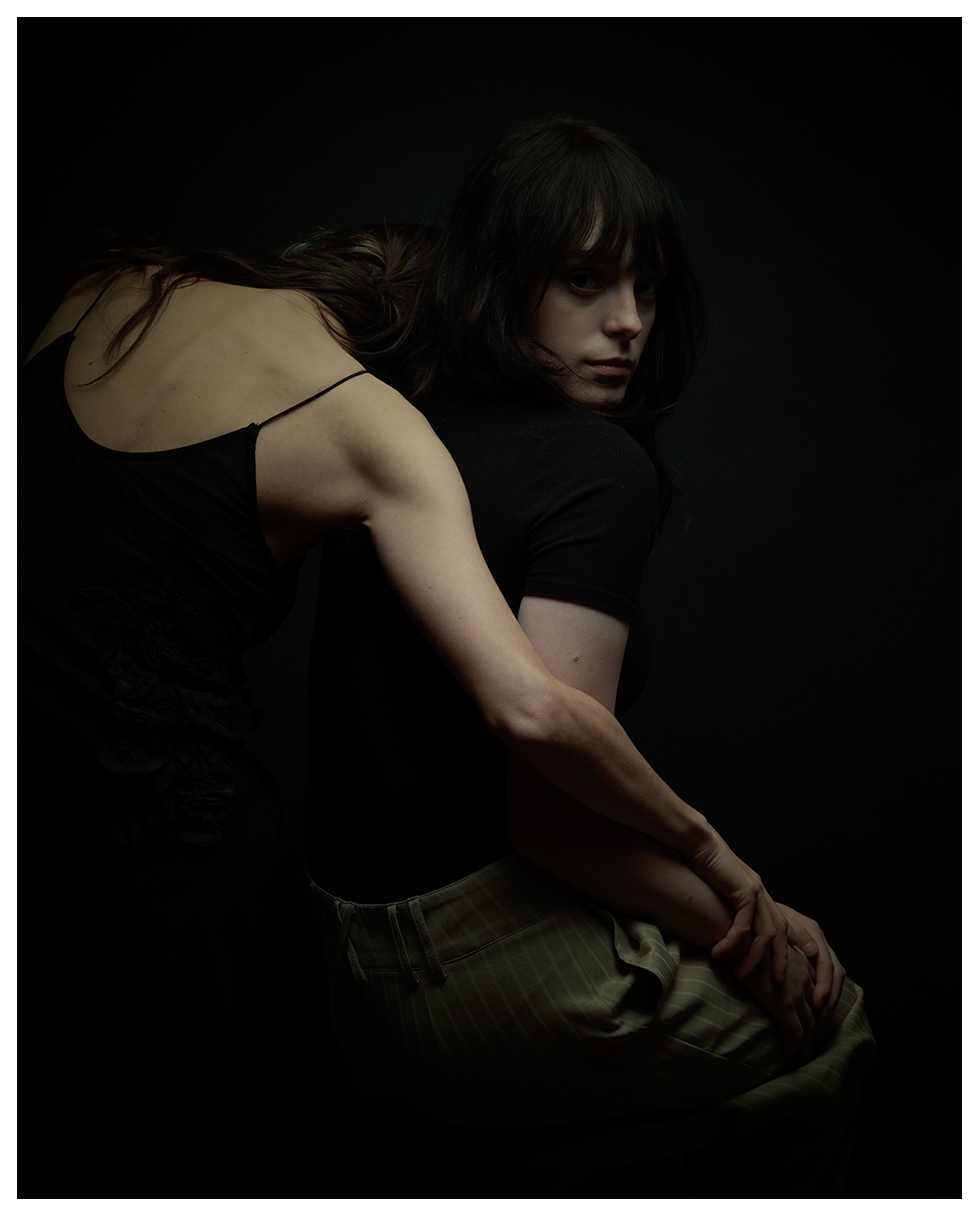
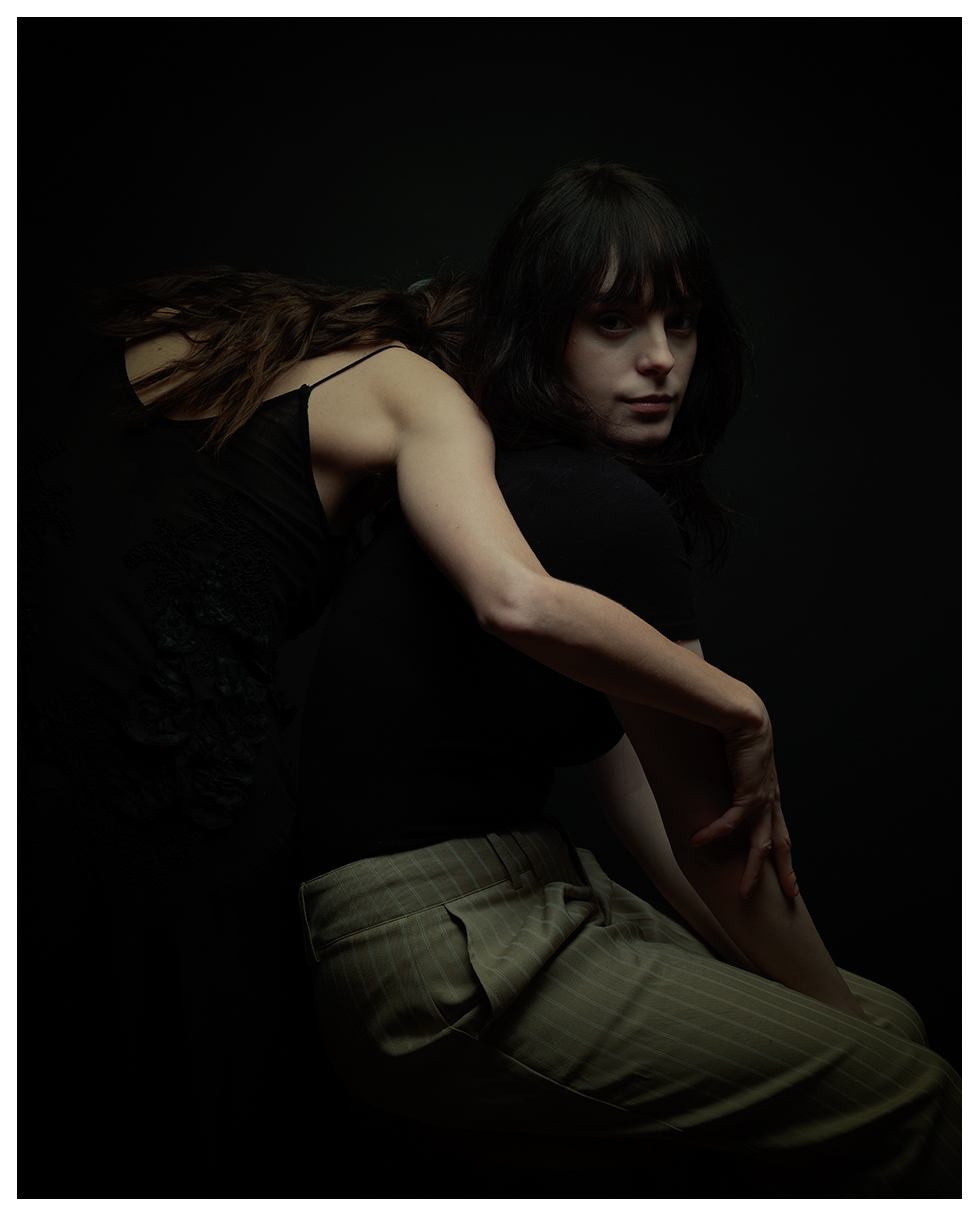

Amy Helmick
December 4, 2022 at 18:11
I enjoyed your interview very much and am looking forward to see your AiR project. You are an example for the creation of meaningful work.
Justyna
December 12, 2022 at 21:24
Thank you Amy for your kind words.
Richard Hutson
December 4, 2022 at 23:30
The interview with Justyna and the accompanying photographs have my attention. Of all photography genres, portraiture extraordinarily reaches into my soul. My introduction to nude photos came in 1969 from a collection of Victor Skrebneski’s work published by The Ridge Press, inc.
I am looking forward to Justyna’s residency.
Justyna
December 12, 2022 at 22:23
Thank you Richard . Skrebneski’s male nudes in particular are very inspirational .
Grant Wells
December 5, 2022 at 01:24
Really looking forward to this.
Justyna
December 12, 2022 at 21:28
Thanks Grant , much appreciate your interest.
Rod Howes
December 5, 2022 at 08:03
Great introduction to a fabulously talented artist. I’m very much looking forward to this series.
The ‘Artist in Residence’ program is definitely Value Adding.
Justyna
December 12, 2022 at 22:27
Many thanks Rod .
Cory Ingram
December 12, 2022 at 05:12
Looking forward to your sessions. Wondering…if there audio with the clips?
Justyna
December 12, 2022 at 22:29
Thanks Cory ! I am afraid there is no audio with the short clips , I will instead provide a written words with each part.
Stephen Smith
December 18, 2022 at 16:32
Justyna, welcome to the club! After a 40-year hiatus, I returned to the darkroom four years ago and haven’t looked back. The contemplation, the process, the artistry and handcraft, the tactile result are all very satisfying. I scan my b&w negatives only to post on-line. I have followed your work closely with great interest and admiration for the last years. All of your b&w work is easily achieved by a good printer in the darkroom. Actually I thought it all was! Am enjoying accompanying your journey in this series. Look forward to the next one.
Justyna
December 19, 2022 at 20:30
Thanks a lot Stephen 🙂
Ian Pye
December 21, 2022 at 00:22
Hi. Your interview was very interesting thank you. During the interview you said you cant work in digital format (because you cant capture the moment??) and working in medium format requires the discipline needed to to get the capture. Im wondering why you feel that digital photography is missing that?
Justyna
December 22, 2022 at 22:35
I don’t recall saying I don’t work in digital because it cannot capture the moment. Because I do use digital, as well as analogue. What I was talking about was not liking the aspect ratio, 3:2, of most dslr cameras. And the cameras I was using at the time had a resolution that was too low to make large prints from. So this resulted in me making images by shooting in sections, and piecing these images together to make my final prints, usually in a 5:4 aspect ratio. By moving up to medium format,[digital] I am now able to capture moments in one frame, rather than construct them in post as I had been doing previously.
Rod Howes
December 21, 2022 at 05:44
Session 3 asks as many questions as it answers. Like you, I have an analogue beginning and loved my time in the darkroom. I found it very therapeutic. I also did color work for which there is no real safelight. I’d love to reopen my old darkroom. I am exclusively digital now but find LightRoom to be somewhat soulless compared to the darkroom even though it offers more control options especially for color work.
I’m very much looking forward to your next session on combining the two workflows.
Loving the way you compose your images.
R.
Justyna
December 22, 2022 at 22:35
Thank you Rod .
M7eTvTTVQ!u#C6TG
December 23, 2022 at 02:49
Justyna, I enjoyed the interview very much and appreciate how open you were. One statement in particular really made me think. You said something like “taking a portrait is really a self – portrait”. I believe you said this specifically in relation to the portraits of your daughter and perhaps how she looks like you or reminded you of yourself at her age. But I wonder if there’s a more general truth in that statement. Do you find yourself looking for – or finding – reflections of yourself in your portraits of others?
Justyna
December 26, 2022 at 20:08
Hi there.
Thanks very much . The series I did with Nell was a “self portrait” just in a different body and it was an exception, she was the connection between my adult self and my memories of my childhood.
I do not look for or try to find reflections of my self in my portraits of others.
Richard Hutson
December 28, 2022 at 02:41
Justyna, I enjoyed seeing how you set up the shots for your self-portraits and so easily carried out various poses. The poses with Nell are beautiful.
Justyna
December 31, 2022 at 04:00
Thank you Richard
Kevin
December 31, 2022 at 12:30
Hi Justyna,
I really loved your Artist-in-Residence series. Your time in the darkroom took me back to my days as a teenager when I used to print my own B&W 35mm images’ in the bathroom long before I went digital. Your experimentation on both yourself and yourself and your daughter was fascinating and thought provoking and I look forward to catching up on any future projects you may undertake. I have tended towards landscape and travel photography in the past but at 71 I am becoming a little less mobile and therefore considering moving more towards portraiture. Also after many years of being digital only I am contemplating purchasing a Mayima medium format film camera; although it is unlikely I will go back to a true darkroom but scanning the negatives and editing in Photoshop instead; however, who knows.
Stay safe.
Justyna
January 3, 2023 at 21:23
Thank you Kevin(sorry for the delay in replaying) . Your comment and time is much appreciated . All the best with moving towards portraiture !
Richard Hutson
January 5, 2023 at 21:40
Justyna, Thank you for showing us your printing process. The finished photographs are beautiful.
Justyna
January 5, 2023 at 23:00
Thanks Richard , these are only test prints really . I hope to make much larger editioned prints in the near future .
Julien
January 6, 2023 at 18:47
Thanks you for taking us into this intimate creative journey. This was very inspiring, calm and refreshing.
Justyna
January 6, 2023 at 21:20
Manny thanks Julien for such a kind words !